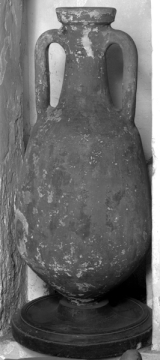Explore Collections


You are here:
CollectionsOnline
/
A Roman clay amphora
Browse
A Roman clay amphora
Roman Imperial
Grey clay
Height (excluding modern turned wood pedestal): 84cm
Museum number: M451
On display: Basement West Corridor
All spaces are in No. 13 Lincoln's Inn Fields unless identified as in No. 12, Soane's first house.
For tours https://www.soane.org/your-visit
Curatorial note
An amphora of the Dressel 6A type (by comparisons with the University of Southampton's Archaeology Data Service), indicating a date between Late 1st century BC and the middle of the 1st century AD, with spout or mouth and two handles leading from the neck to the body. As a Dressel 6A, Cornelius Vermeule's cataloguing of this item as a 'water jug' is incorrect and the Southampton database identifies sources mentioning wine and garum, but states that it has long been thought that this form carried olive oil from Istria.
There are two inscriptions:
On the handle: STROB
On the rim: MIOLIO? ?FFRONT
These appear to have been done at some point after the amphora was fired (i.e. neither is an amphora stamp applied by the manufacturer), indicating reuse. However, it is hard to know how long after firing these were added and the meaning is obscure. Louise Hodgson has noted that the lettering seems rather fine for such a utilitarian item, which possibly suggests a modern(ish) addition intended to increase the price.
Cornelius Vermeule noted that the shape and size was common to such utilitarian objects in the Roman Imperial period and continued in use in Medieval and later times in much the same shape and material. This example is probably of the Roman Imperial period and from Central Italy.
We are grateful to Dr. Louise Hodgson for her assistance with this catalogue entry.
There are two inscriptions:
On the handle: STROB
On the rim: MIOLIO? ?FFRONT
These appear to have been done at some point after the amphora was fired (i.e. neither is an amphora stamp applied by the manufacturer), indicating reuse. However, it is hard to know how long after firing these were added and the meaning is obscure. Louise Hodgson has noted that the lettering seems rather fine for such a utilitarian item, which possibly suggests a modern(ish) addition intended to increase the price.
Cornelius Vermeule noted that the shape and size was common to such utilitarian objects in the Roman Imperial period and continued in use in Medieval and later times in much the same shape and material. This example is probably of the Roman Imperial period and from Central Italy.
We are grateful to Dr. Louise Hodgson for her assistance with this catalogue entry.
Soane collections online is being continually updated. If you wish to find out more or if you have any further information about this object please contact us: worksofart@soane.org.uk


